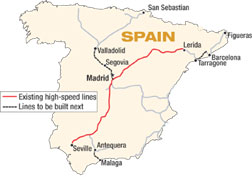| + click to enlarge |
 |
... Antequera to Malaga. Another five sections of network, exceeding 1,400 km, are still in construction and more are planned.
On the 125-km route from Barcelona to the Pyrenees tunnel, ADIF recently awarded the last three civil contacts, for 19 km worth of line. With a total value of $280 million, they are among numerous contracts on this section. A second, western Pyrenees crossing is planned and will someday link the French-Spanish rail networks.
ADIF’s French counterpart, Réseau Ferré de France (RFF), is planning an extension of the South Europe Atlantic route to cross the border on the Bay of Biscay coast between Hendaye and San Sebastian, at an estimated cost of $6 billion. But first, RFF aims to get the Tours-Bordeaux section done by 2015. RFF recently shortlisted Paris-based teams led by Bouygues S.A. and Vinci Group, along with Eiffage by itself, to bid for the BOT contract.
 ADIF |
Bidders had expected to receive bid documents this July, says Christian Gazaignes, chief executive officer of Bouygues Travaux Publics, Paris. But RFF plans to start the bidding maybe next month. “We want to be sure we have a success,” explains Jean-Marc Charoud, director of investment operations. “We have to take some time to make assessments of (future) traffic.”
At 300 km long, the Tours-Bordeaux line is nearly three times longer than the U.K.’s recently completed Channel Tunnel rail, called HS1. But it is forecast to cost around 40% less. While HS1 is largely in tunnels, the French project is mainly at grade with numerous small structures and one large viaduct over the Dordogne River, says Gazaigne. He estimates total construction cost at about $7.3 billion.

ADIF Eleven viaducts totaling over three miles also mark the new high-speed route.
|
With the opening of the 300-km Paris-Metz track this summer, RFF is now planning up to $15 billion in investments on three more projects between 2009 and 2016, says Charoud. One would extend the eastern line from Paris beyond Metz by 106 km to Vendenheim, north of Strasbourg at the German border. An 80-km project would upgrade the Nîmes-Perpignan line, providing a bypass to Montpellier. The third project would push the Paris-to-Brittany line further west by 182 km, from Le Mans to Rennes.

RFF Crossing the Pyrenees marks the beginning of a plethora of high-speed rail links for Spain.
|
As French and Spanish railroad engineers face a long horizon of high-speed development, their British counterparts look on in envy. Getting HS1 built along its present route took a lot of work by a small team of directors at Arup Group, London. Arup went beyond the normal remit of a design firm by successfully lobbying Parliament and the government for project approval more than a decade ago, recalls Mark Bostock, one of the team members.
HS1 opened last month and Bostock is already working on plans for its extension to Heathrow Airport and into central England. But in the absence of a Continental-style rolling program, he asks: “Where are the big hitters who can back us again?”